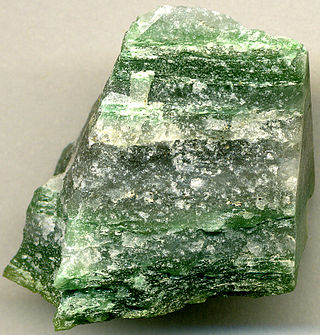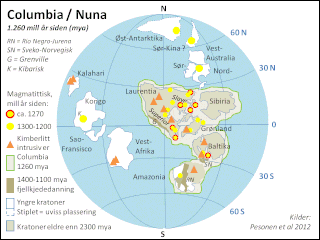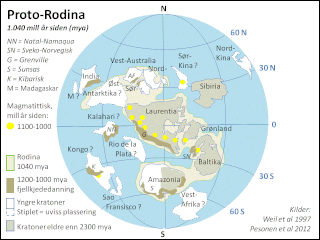
The geologic time scale or geological time scale (GTS) is a representation of time based on the rock record of Earth. It is a system of chronological dating that uses chronostratigraphy and geochronology. It is used primarily by Earth scientists to describe the timing and relationships of events in geologic history. The time scale has been developed through the study of rock layers and the observation of their relationships and identifying features such as lithologies, paleomagnetic properties, and fossils. The definition of standardized international units of geologic time is the responsibility of the International Commission on Stratigraphy (ICS), a constituent body of the International Union of Geological Sciences (IUGS), whose primary objective is to precisely define global chronostratigraphic units of the International Chronostratigraphic Chart (ICC) that are used to define divisions of geologic time. The chronostratigraphic divisions are in turn used to define geochronologic units.

The Neoproterozoic Era is the unit of geologic time from 1 billion to 538.8 million years ago.
The Precambrian is the earliest part of Earth's history, set before the current Phanerozoic Eon. The Precambrian is so named because it preceded the Cambrian, the first period of the Phanerozoic Eon, which is named after Cambria, the Latinised name for Wales, where rocks from this age were first studied. The Precambrian accounts for 88% of the Earth's geologic time.
Tertiary is an obsolete term for the geologic period from 66 million to 2.6 million years ago. The period began with the demise of the non-avian dinosaurs in the Cretaceous–Paleogene extinction event, at the start of the Cenozoic Era, and extended to the beginning of the Quaternary glaciation at the end of the Pliocene Epoch. The time span covered by the Tertiary has no exact equivalent in the current geologic time system, but it is essentially the merged Paleogene and Neogene periods, which are informally called the Early Tertiary and the Late Tertiary, respectively.

The Hadean is a geologic eon of Earth's history, and is the first and oldest of the four known eons of Earth, preceding the Archean. The Hadean started with the planet's formation about 4.54 Bya, now defined as Mya set by the age of the oldest solid material in the Solar System, found in some meteorites about 4.567 billion years old. The Hadean ended, as defined by the International Commission on Stratigraphy (ICS), 4 billion years ago.

The Proterozoic is a geological eon spanning the time interval from 2500 to 538.8 million years ago. It is the most recent part of the Precambrian "supereon". It is also the longest eon of the Earth's geologic time scale, and it is subdivided into three geologic eras : the Paleoproterozoic, Mesoproterozoic, and Neoproterozoic.

The Mesoproterozoic Era is a geologic era that occurred from 1,600 to 1,000 million years ago. The Mesoproterozoic was the first era of Earth's history for which a fairly definitive geological record survives. Continents existed during the preceding era, but little is known about them. The continental masses of the Mesoproterozoic were more or less the same ones that exist today, although their arrangement on the Earth's surface was different.

The Eoarchean is the first era of the Archean Eon of the geologic record. It spans 400 million years, from the end of the Hadean Eon 4 billion years ago to the start of the Paleoarchean Era 3600 Mya. The beginnings of life on Earth have been dated to this era and evidence of archaea and cyanobacteria date to 3500 Mya, comparatively shortly after the Eoarchean. At that time, the atmosphere was without oxygen and the pressure values ranged from 10 to 100 bar.

The Tonian is the first geologic period of the Neoproterozoic Era. It lasted from 1000 to 720 Mya. Instead of being based on stratigraphy, these dates are defined by the ICS based on radiometric chronometry. The Tonian is preceded by the Stenian Period of the Mesoproterozoic Era and followed by the Cryogenian.
The Cryptic era is an informal term for the earliest geologic evolution of the Earth and Moon. It is the oldest (informal) era of the Hadean eon, and it is commonly accepted to have begun close to about 4.533 billion years ago when the Earth and Moon formed, and lasted to about 4.15 billion years ago. No samples exist to date the transition between the Cryptic era and the following Basin Groups era for the Moon, though sometimes it is stated that this era ended 4150 million years ago for one or both of these bodies. Neither this time period, nor any other Hadean subdivision, has been officially recognized by the International Commission on Stratigraphy.
bya or b.y.a. is an abbreviation for "billion years ago". It is commonly used as a unit of time to denote length of time before the present in 109 years. This initialism is often used in the sciences of astronomy, geology, and paleontology.

A billion years or giga-annum (109 years) is a unit of time on the petasecond scale, more precisely equal to 3.16×1016 seconds (or simply 1,000,000,000 years).

The Statherian Period is the final geologic period in the Paleoproterozoic Era and lasted from 1800 Mya to 1600 Mya. Instead of being based on stratigraphy, these dates are defined chronometrically.

The Calymmian Period is the first geologic period in the Mesoproterozoic Era and lasted from 1600 Mya to 1400 Mya. Instead of being based on stratigraphy, these dates are defined chronometrically.

The Ectasian Period is the second geologic period in the Mesoproterozoic Era and lasted from 1400 Mya ago to 1200 Mya. Instead of being based on stratigraphy, these dates are defined chronometrically.

The Stenian Period is the final geologic period in the Mesoproterozoic Era and lasted from 1200 Mya to 1000 Mya. Instead of being based on stratigraphy, these dates are defined chronometrically. The name derives from narrow polymetamorphic belts formed over this period.
The Famennian is the latter of two faunal stages in the Late Devonian Epoch. The most recent estimate for its duration estimates that it lasted from around 371.1 million years ago to 359.3 million years ago. An earlier 2012 estimate, still used by the International Commission on Stratigraphy, estimated that it lasted from 372.2 million years ago to 358.9 million years ago. It was preceded by the Frasnian stage and followed by the Tournaisian stage.

The galactic year, also known as a cosmic year, is the duration of time required for the Sun to orbit once around the center of the Milky Way Galaxy. One galactic year is approximately 230 million Earth years. The Solar System is traveling at an average speed of 230 km/s (828,000 km/h) or 143 mi/s (514,000 mph) within its trajectory around the Galactic Center, a speed at which an object could circumnavigate the Earth's equator in 2 minutes and 54 seconds; that speed corresponds to approximately 1/1300 of the speed of light.
Early Earth is loosely defined as Earth in its first one billion years, or gigayear (Ga, 109y). Early Earth is defined as encompassing approximately the first gigayear in the evolution of the planet from its initial formation in the young Solar System at about 4.55 Ga to sometime in the Archean eon in approximately 3.5 Ga. On the geologic time scale, this comprises all of the Hadean eon, starting with the formation of the Earth about 4.6 billion years ago, and the Eoarchean, starting 4 billion years ago, and part of the Paleoarchean era, starting 3.6 billion years ago, of the Archean eon.
In stratigraphy, paleontology, geology, and geobiology, an erathem is the total stratigraphic unit deposited during a certain corresponding span of time during an era in the geologic timescale.












